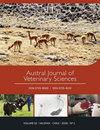城市沿海地区家畜和野生动物粪便中弯曲菌的脱落área
IF 0.8
4区 农林科学
Q3 VETERINARY SCIENCES
引用次数: 3
摘要
摘要:空肠弯曲杆菌和大肠弯曲杆菌是世界范围内引起食物相关性腹泻的主要原因。然而,其他弯曲菌,如其他弯曲杆菌属、Arcobacter属和幽门螺杆菌属,也被认为是新出现的病原体,尽管它们并不经常通过传统培养方法分离。此外,弯曲杆菌由于在动物和人类医学中使用抗生素,对抗生素的耐药性越来越强。有人认为,养宠物会增加患弯曲杆菌病的风险。然而,温度、湿度和恶劣的卫生条件等环境因素也与动物的最高脱落率有关。本研究评估了城市沿海地区68只(66.0%)家畜(主要是狗(n=61)和35只(33.9%)野生动物(分属13种8目)的弯曲菌粪便脱落情况。21个样本(20.4%)中没有一个出现肠胃炎症状,而通过培养仅检测到6个样本(5.8%),即upsaliensis弯曲杆菌(n=4,狗)、空肠弯曲菌(n=1,狗)和butzleri圆杆菌(n=1)。没有一个分离株对环丙沙星有耐药性,但有两个对红霉素有耐药性,即布兹勒菌(MIC=8 pg/ml)和杜氏梭菌(MIC=128 pg/ml)。关于毒力因子,只有一个空肠弯曲菌分离株对cdtC和cadF基因呈阳性,而一个布兹勒里A.butzleri分离株对cadF和ciaB基因呈阳性。这是第一项评估智利瓦尔帕莱索城市沿海地区动物粪便中弯曲菌脱落情况的研究。尽管空肠弯曲菌和其他新出现的弯曲菌主要从宠物狗身上检测到,而且检测率很低,但还需要进一步的调查来评估这些人畜共患细菌的潜在传播或它们在宠物和主人之间的抗生素耐药性。本文章由计算机程序翻译,如有差异,请以英文原文为准。
Faecal shedding of campylobacteria among domestic and wild animals from an urban coastal área
Abstract: Campylobacter jejuni and Campylobacter coli are the leading cause of food-related diarrhea worldwide. However, other campylobacteria such as other Campylobacter spp., Arcobacter spp. and Helicobacter spp. are also recognised as emerging pathogens, although they are not frequently isolated by traditional culturing methods. Moreover, Campylobacter spp. have become increasingly resistant to antibiotics due to antibiotic usage in animal and human medicine. It has been suggested that pet ownership increases the risk for campylobacteriosis. However, environmental factors such as temperature, humidity, and poor sanitation conditions have also been associated with the highest rates of shedding among animals. This study assessed the faecal shedding of campylobacteria in an urban coastal area among 68 (66.0%) domestic animals, mainly dogs (n=61), and 35 (33.9%) wild animals belonging to 13 species and eight orders. None of them had symptoms of gastroenteritis and campylobacteria were detected by PCR in 21 samples (20.4%), while only six (5.8%) were detected by culturing, i.e. Campylobacter upsaliensis (n=4, dogs), C. jejuni (n=1, dog) and Arcobacter butzleri (n=1, chicken). None of the isolates was resistant to ciprofloxacin, but two were resistant to erythromycin, i.e. A. butzleri (MIC=8 pg/ml) and C. upsaliensis (MIC=128 pg/ml). Regarding the virulence factors, only one isolate of C. jejuni was positive for cdtC and cadF genes and one isolate of A. butzleri was positive for cadF and ciaB genes. This is the first study to assess the faecal shedding of campylobacteria in animals from the urban coastal area of Valparaiso, Chile. Although C. jejuni and other emerging campylobacteria were detected mainly from pet dogs and in a low rate, further investigations are needed to assess the potential transmission of these zoonotic bacteria or their antibiotic resistance between pets and owners.
求助全文
通过发布文献求助,成功后即可免费获取论文全文。
去求助
来源期刊

Austral Journal of Veterinary Sciences
Veterinary-General Veterinary
CiteScore
1.60
自引率
0.00%
发文量
18
期刊介绍:
Austral Journal of Veterinary Sciences (formerly Archivos de Medicina Veterinaria) publishes original scientific contributions in English, containing the latest developments and discoveries in veterinary sciences. The journal covers topics such as animal health and production, preventive medicine, zoonosis, pharmacology and therapeutics, methods of diagnosis, and other areas related to the veterinary field.
Austral Journal of Veterinary Sciences aims to divulge information about advances in veterinary medicine among universities, research centres, industries, government agencies, biologists, agronomists and veterinarians.
 求助内容:
求助内容: 应助结果提醒方式:
应助结果提醒方式:


